The Dell Precision 5680 is a mid-range 16-inch mobile workstation with the latest Intel processors and NVIDIA Ada Generation professional GPUs.
Dell Precision 5680 Specifications
Not to be confused with the Dell Precision 5860, the Precision 5680 is a mobile workstation with a 16-inch screen. This mid-tier model sits between the budget-minded Precision 3581 and the flagship Precision 7680.
This laptop is powered by 13th generation Intel Core H-class (45-watt) processors, supports 64GB of RAM, and NVIDIA’s RTX Ada Generation graphics cards up to the RTX A5000 16GB. These are expected specifications in this class, and offer plenty of performance for photo, video, and 3D design tasks. The memory ceiling is relatively low because it has just two SODIMM slots; upgrading to the Precision 7680 is required to get more RAM.
The Precision 5680’s full specifications are as follows:
| Processor Options |
|
| Operating System |
|
| Memory Options | 2x SODIMM, 64GB DDR5-6000 max (2x 32GB) |
| Graphics |
|
| Storage Options | Up to 4TB Gen 4 SSD |
| Dimensions and Weight |
|
| Wireless |
|
| Battery Options |
|
| Display Options |
|
| Camera |
|
| Ports and Slots |
|
Dell Precision 5680 Build and Design
Unlike 17- and 18-inch laptops, the 16-inch Precision 5680 (13.6 x 9.0 x 0.46 inches, WDH) is portable enough to fit into a backpack for daily trips to the office or worksites. It’s impressively thin and dips under the five-pound mark, at 4.49 pounds.
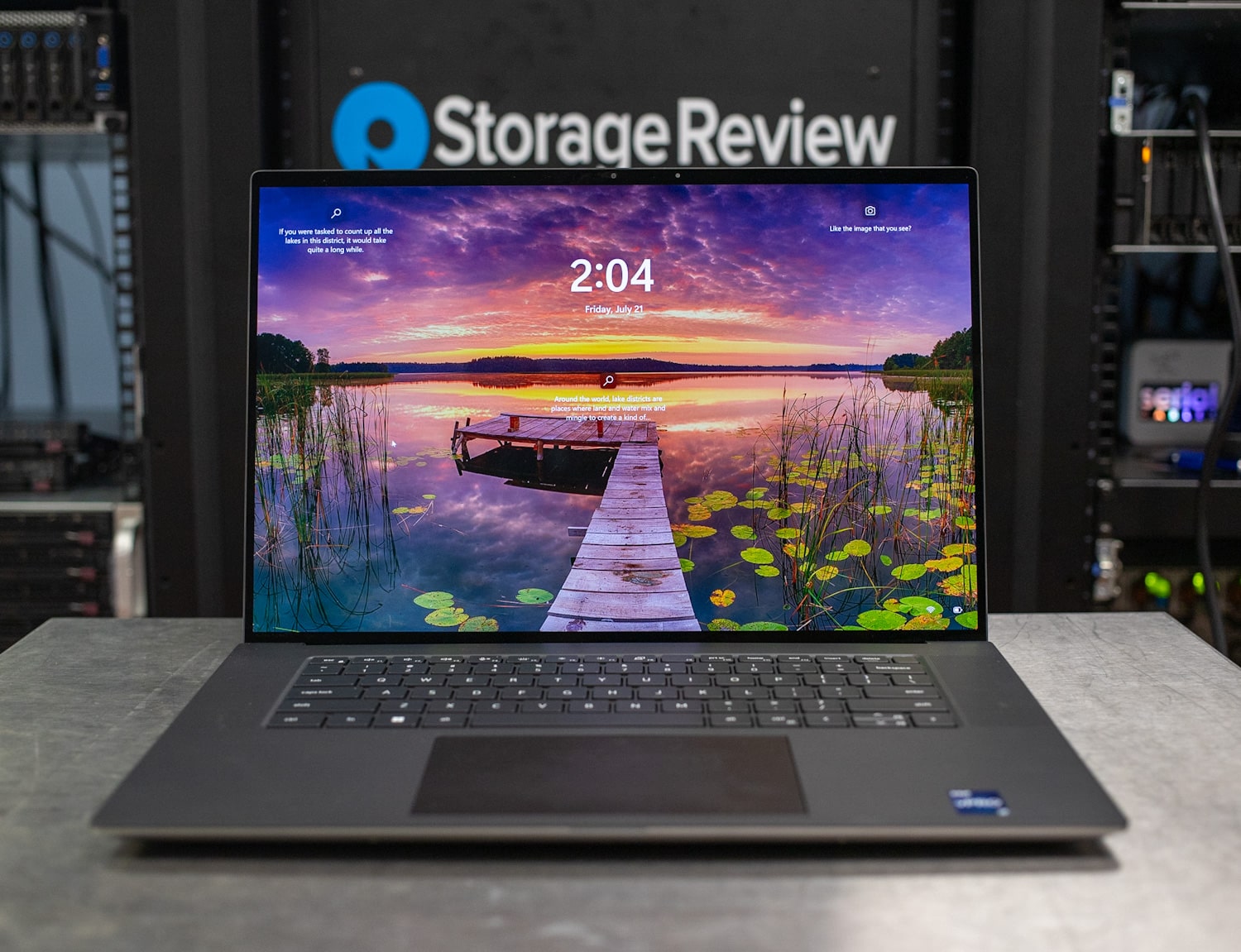
The Precision 5680’s optional UHD OLED screen offers a brilliant picture.
Chassis strength is strong as expected from a Dell Precision 5000 series; an all-metal design means it doesn’t bend or show much flex. The lid is also rigid and seems to offer the screen good protection.
Higher-end laptops like this are moving back to the 16:10 screen aspect ratio we enjoyed so many years ago. (The entry-level Precision 3581 sticks with the narrow 16:9 aspect ratio, so 16:10 is a major reason to step up to the Precision 5680.) Our review model has the optional UHD (3840 x 2400) OLED screen, which looks fantastic. OLED technology brings colors to life and has exceptional contrast and is a great choice for color-sensitive work. (You’ll nonetheless want to calibrate it for that purpose.) This screen also supports touch.
Port selection is where the Precision 5680 is weak for a laptop this large. The left edge holds two Thunderbolt 4 (USB-C) ports, a universal audio jack, HDMI 2.0 video output, and a SmartCard reader while the right edge has a full-size SD card reader and one USB-C port (non-Thunderbolt) that supports DisplayPort over USB-C. The included power adapter connects to either Thunderbolt 4 port.
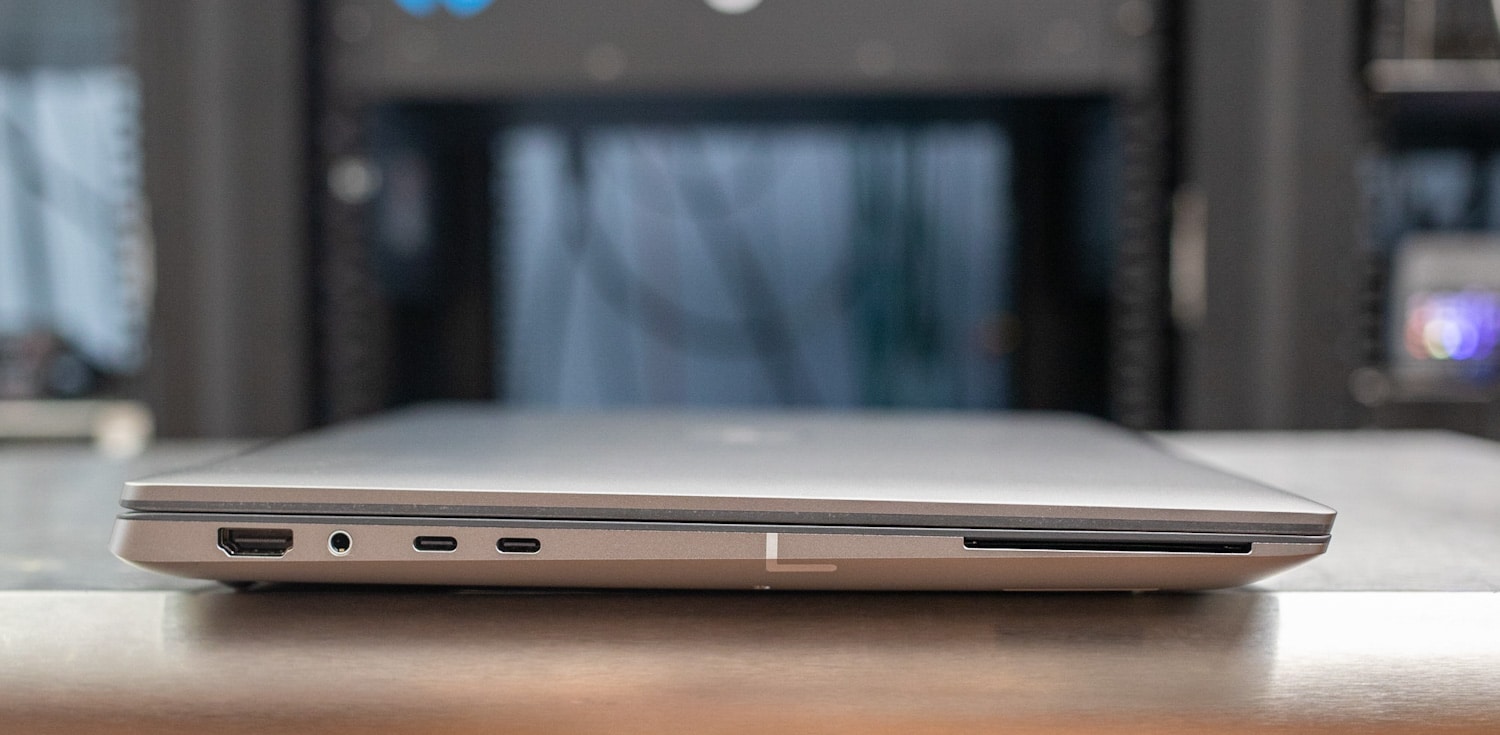
The left edge holds HDMI 2.0, a universal audio jack, two Thunderbolt 4 ports, and a SmartCard reader.
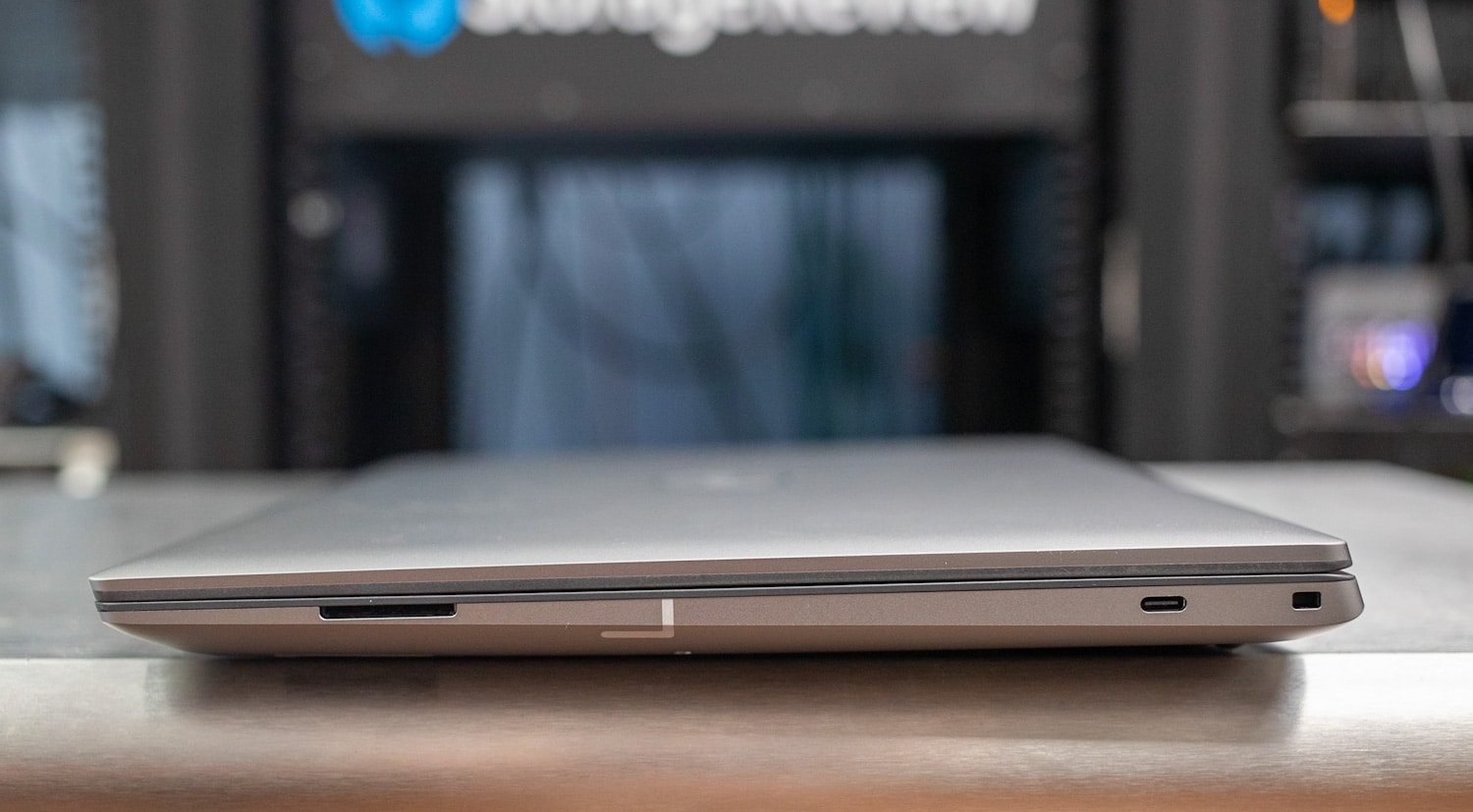
A full-size SD card reader, a USB-C port, and a wedge lock slot are on the right.
Having no USB-A ports is disappointing. Let’s face it – the traditional rectangular port isn’t going away anytime soon. At least Dell ships the Precision 5680 with a USB-C to USB-A dongle, though you’ll need to remember to carry it with you. Internally, the Precision 5680 has an Intel AX211 wireless card with Wi-Fi 6E and Bluetooth 5.2.
The Precision 5680’s keyboard has a satisfying tactile feel though key travel is relatively short. The white backlighting is easy to see in the dark. The layout unfortunately suffers from half-height up and down arrow keys sandwiched between full-size left and right arrows, which is always confusing and results in missed keystrokes. Dedicated Home, End, Page Up, Insert, and Delete keys are on the top row, but Page Up and Page Down require using Fn-key combos with the arrow keys. There’s no number pad, which some laptops this size include. Overall, it seems like Dell could have done more with this keyboard given the size of this laptop.
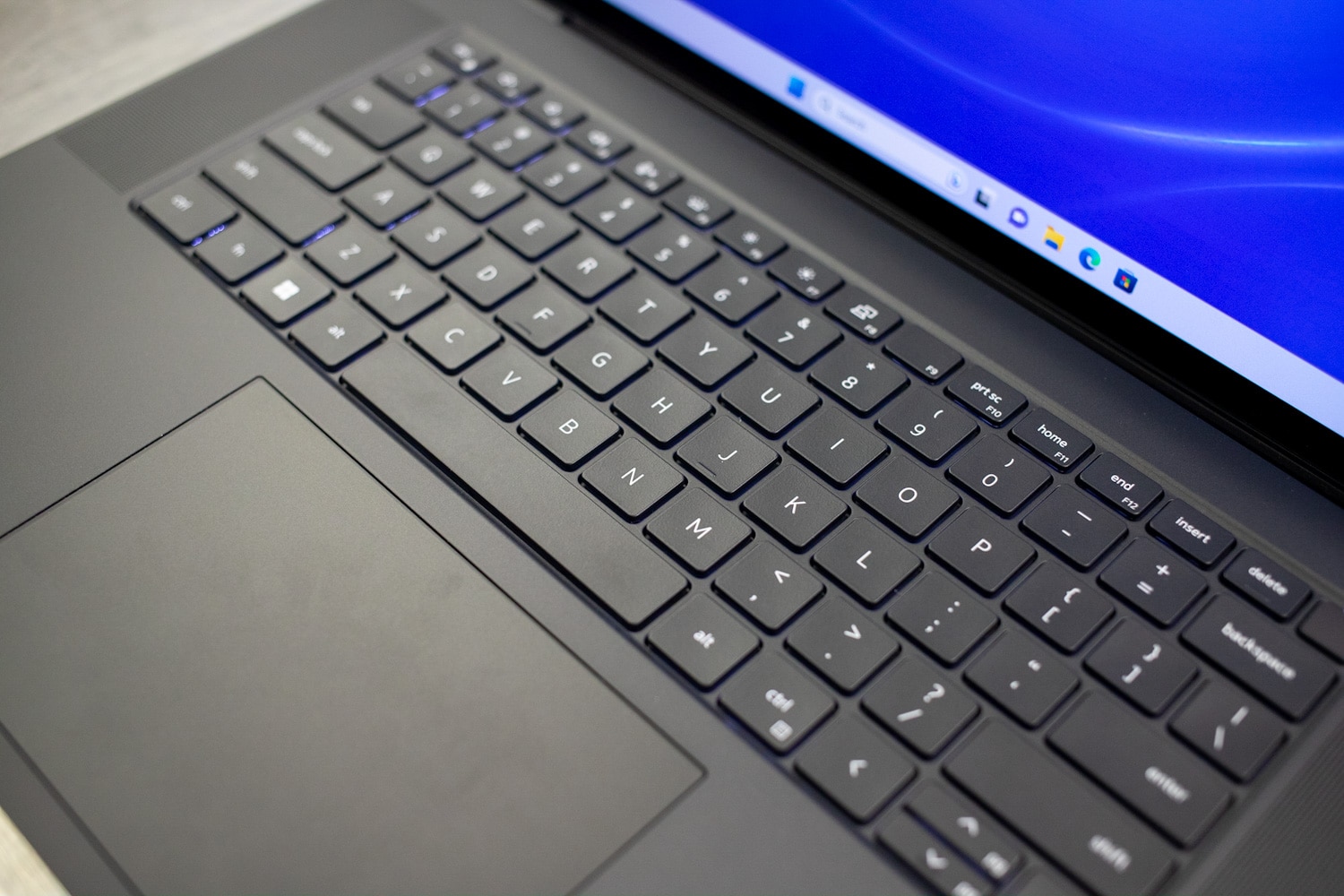
The Precision 5680 offers an enjoyable typing feel though it lacks a number pad.
The power button at the top right corner doubles as a fingerprint reader. The 1080p webcam over the display supports infrared (IR) and can be used for facial recognition login with Windows Hello.
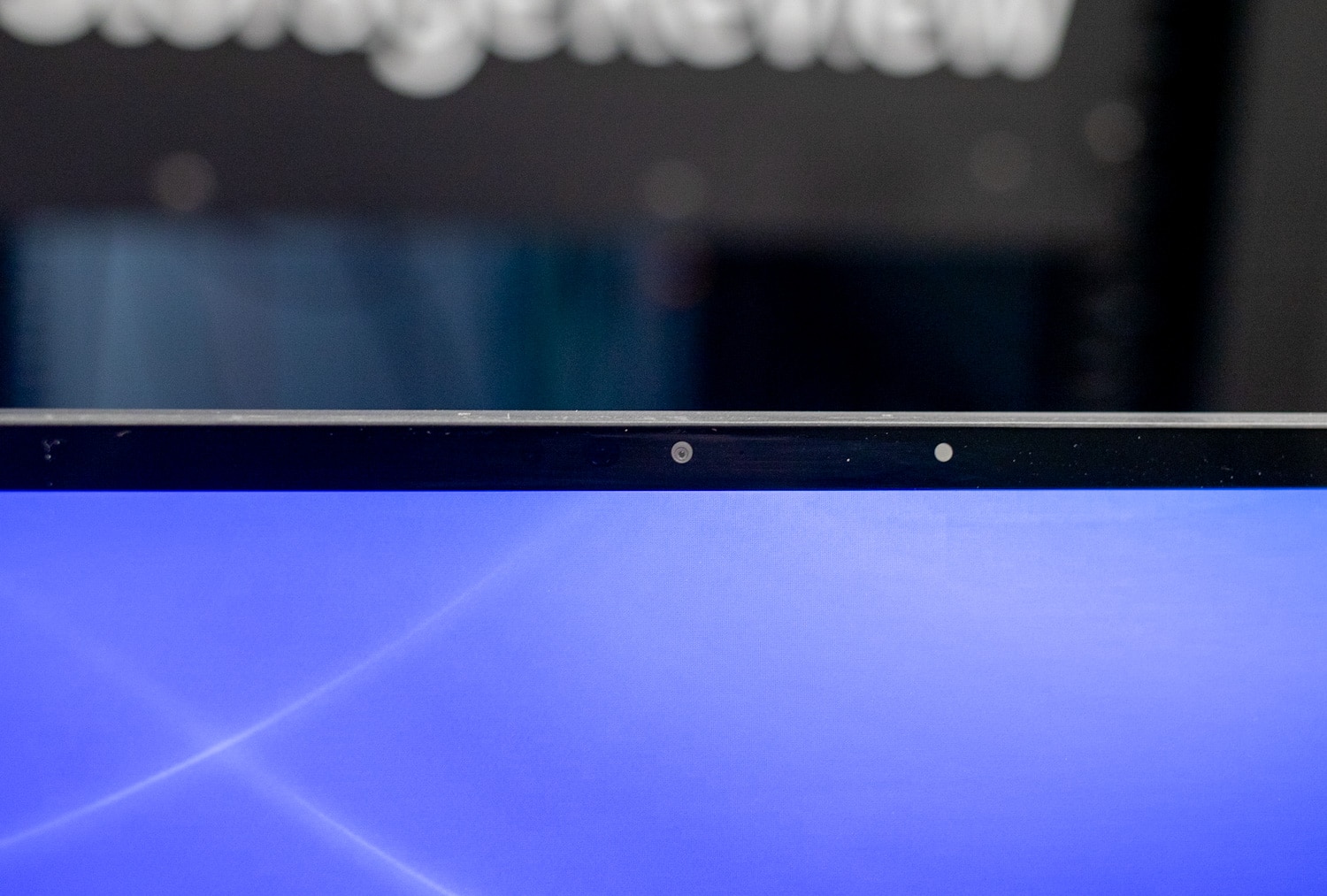
The 1080p webcam has an infrared function for facial recognition.
The touchpad, meanwhile, is very nicely sized and easy to use. There is no pointing stick or alternate set of mouse buttons as you’d get on a ThinkPad workstation.
Dell Precision 5680 Upgrades
The Precision 5680’s bottom panel comes off after unscrewing the Torx T6 screws and prying it from the back. (You’ll need a plastic trim pry tool to pop the clips.)
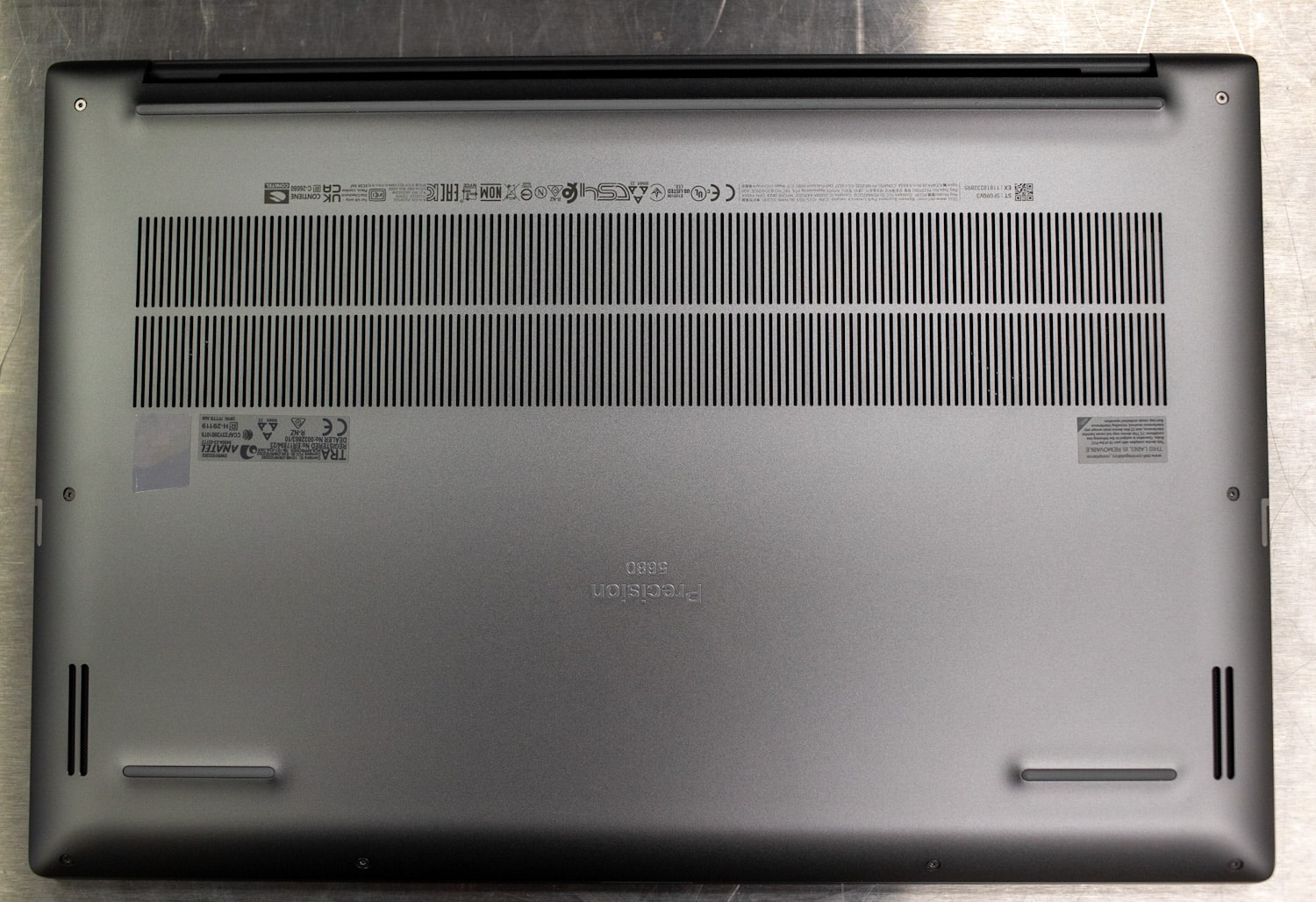
Taking off the bottom panel requires removing several Torx screws.
Under the hood, the battery takes about half the chassis. There are two M.2 2280 (80mm) slots for SSDs, both labeled and covered by heatsinks. The Intel wireless card is soldered to the motherboard and can’t be upgraded. The SODIMM slots are on the other side of the motherboard.
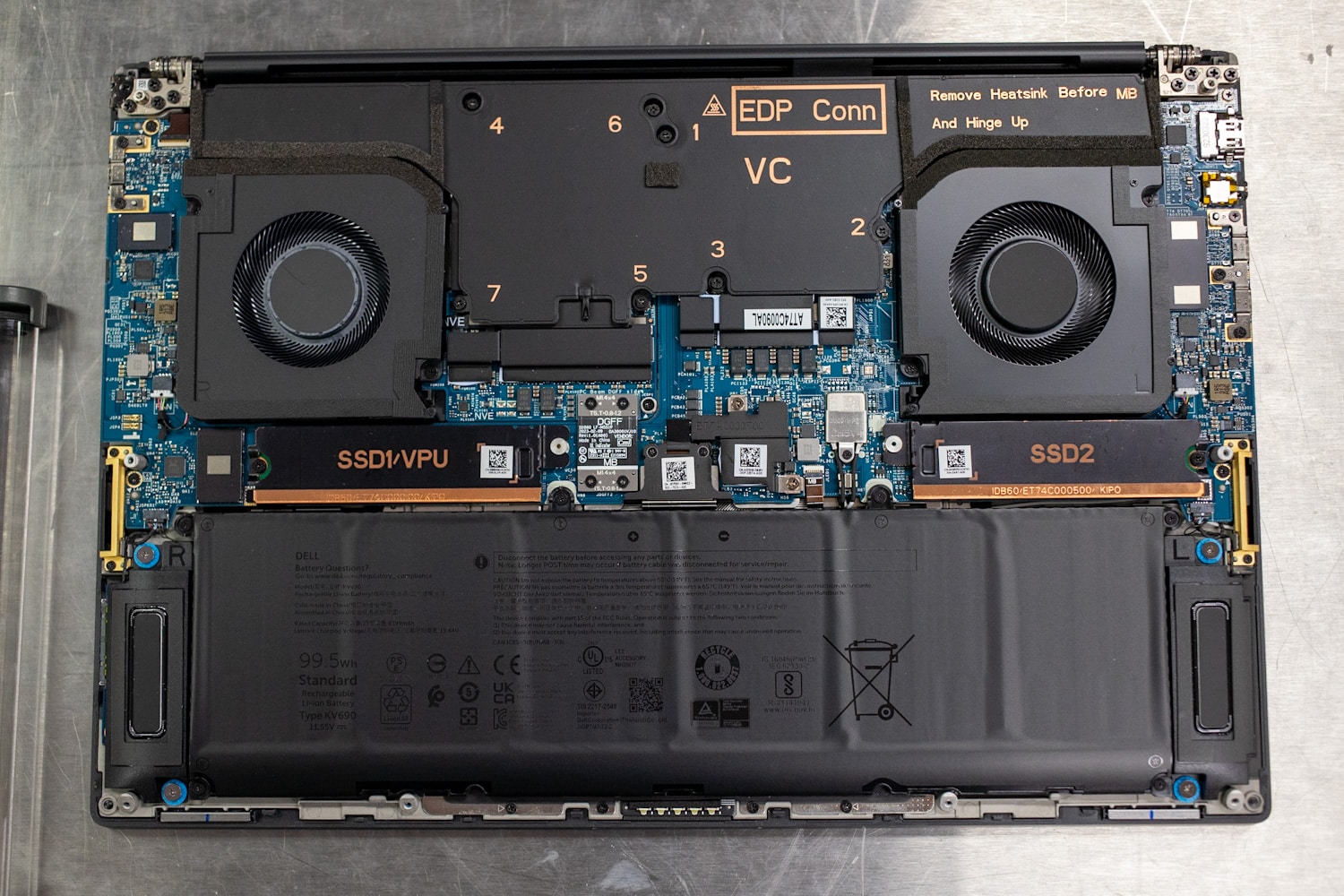
A large heatsink spans the CPU and GPU.
Here’s a look at the internals without the heatsink.
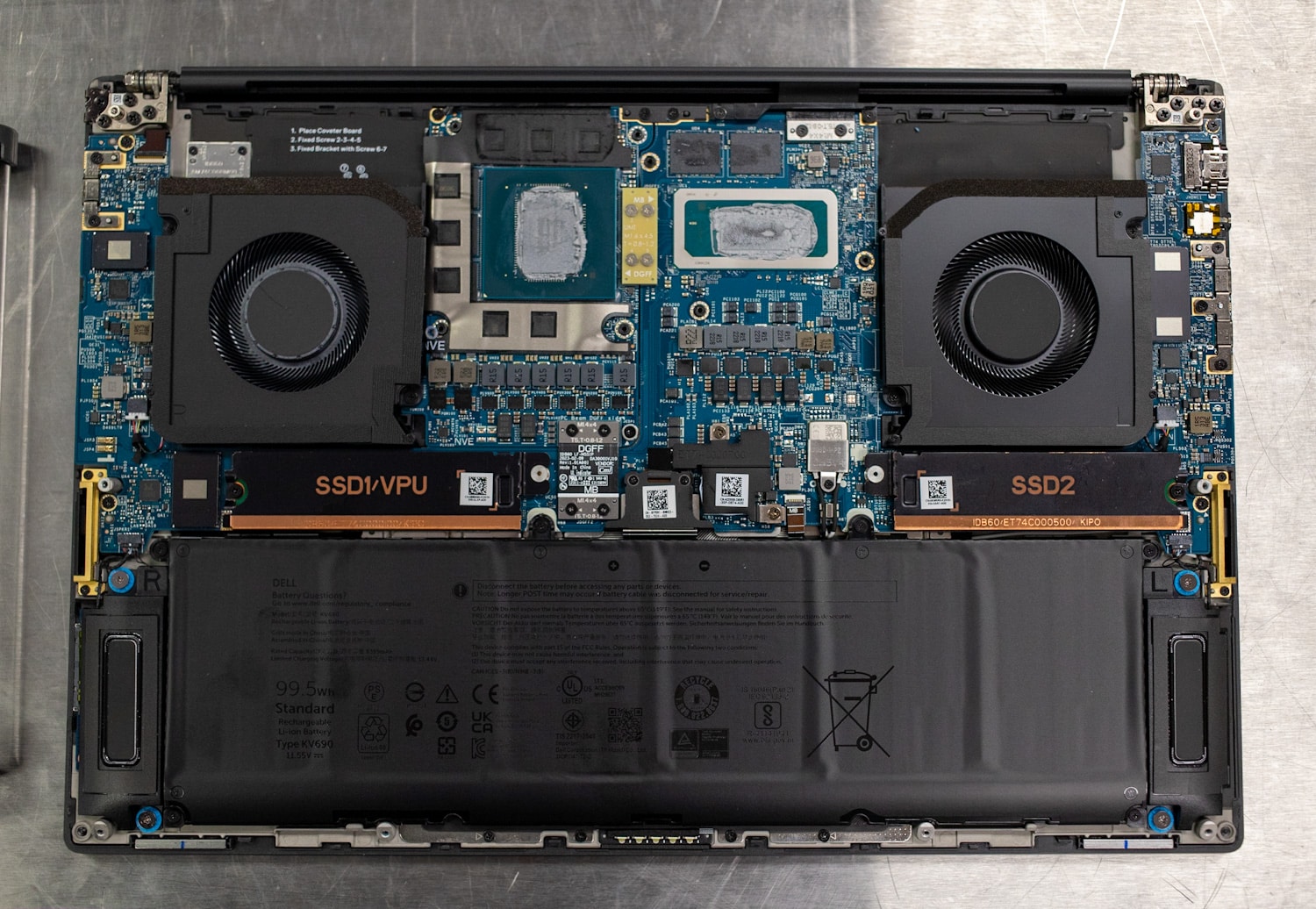
Removing the heatsink reveals the CPU and GPU dies.
Dell Precision 5680 Performance
Our Precision 5680 review unit has the following specifications:
- Intel Core i9-13900H (14-core/20-thread, 2.5-5.4GHz, 45-watt) w/ Intel vPro
- Windows 11 Pro
- NVIDIA RTX A5000 Ada Generation (16GB)
- 32GB DDR5-6000 (2x 16GB)
- 16-inch OLED touch (3840 x 2400)
- 2x 512GB Gen4 SSD in RAID 0
- 6-cell 100Whr battery
- 3-year warranty
This system retails for $6,648.58 on Dell.com, well up from its starting price of $2,789. Dell does almost all of its business sales through channels, not on its site, so be sure to go that route if you’re a business to get a better price.
Our unit has significant upgrades over the base model, which has a Core i5-13600H (12-core/16-thread), integrated Intel graphics, 16GB of RAM, a 256GB SSD, and a 1920 x 1200 screen. We do not consider it a workstation because of its integrated GPU; stepping up to the RTX A1000 6GB is $222.22. Our unit’s RTX A5000 Ada GPU is its single most expensive upgrade ($2,144.18) followed by the Core i9-13900H ($424.29).
We switched up our benchmark routines in the last few months and not much of it overlaps with tests we’ve run on previous laptop workstations, so we’re tossing convention out the window here and using the Dell Precision 5860 Tower for reference comparison. This is intended to show the performance delta between mobile and desktop. The Precision 5860 we tested was $8,888 with a 24-core Xeon w7-2495X, 64GB of RAM, 2x 1TB SSDs in RAID 0, and an NVIDIA RTX A6000 48GB (non-Ada Generation).
SPECviewperf 2020
Our first test is SPECviewperf 2020, the worldwide standard for measuring graphics performance of professional applications under the OpenGL and Direct X application programming interfaces. The viewsets (or benchmarks) represent graphics content and behavior from actual applications, without having to install the applications themselves. The newest version of this benchmark went through major updates late last year, including new viewsets taken from traces of the latest versions of 3ds Max, Catia, Maya, and Solidworks applications. In addition, they added support within all viewsets for both 2K and 4K resolution displays.
The Precision 5860 Tower is obviously faster than the Precision 5680 laptop, but the differences aren’t to the degree that the Precision 5680 couldn’t do 3D design work. These numbers suggest that it’s quite capable, and the benchmarks that follow this one may surprise you.
| SPECviewperf2020 Viewsets (Higher is better) | Dell Precision 5680 Laptop (Core i9-13900H, RTX A5000 Ada) | Dell Precision 5860 (Xeon w7-2495X, RTX A6000) |
| 3dsmax-07 | 96.07 | 140.87 |
| Catia-06 | 68.55 | 89.1 |
| Creo-03 | 120.86 | 125.11 |
| Energy-03 | 38.66 | 42.93 |
| Maya-06 | 220.76 | 327.89 |
| Medical-03 | 32.91 | 35.13 |
| Snx-04 | 263.76 | 480.1 |
| Sw-05 | 133.43 | 171.32 |
SPECworkstation 3
SPECworkstation3 specializes in benchmarks designed for testing all key aspects of workstation performance; it uses over 30 workloads to test CPU, graphics, I/O, and memory bandwidth. The workloads fall into broader categories such as Media and Entertainment, Financial Services, Product Development, Energy, Life Sciences, and General Operations. We are going to list the broad-category results for each, as opposed to the individual workloads. The results are an average of all the individual workloads in each category.
The Precision 5860’s 24-core Xeon and huge memory bandwidth certainly helped it edge out the Precision 5680, but what’s surprising is how close the GPU compute scores were between the two; the Ada Generation architecture of the Precision 5680’s RTX card is impressive.
| SPECworkstation 3 (Higher is better) | Dell Precision 5680 Laptop (Core i9-13900H, RTX A5000 Ada) | Dell Precision 5860 (Xeon w7-2495X, RTX A6000) |
| Media and Entertainment | 3.55 | 5.55 |
| Product Development | 3.69 | 6.1 |
| Life Sciences | 3.6 | 6.08 |
| Financial Services | 3.6 | 6.4 |
| Energy | 3.77 | 6.59 |
| General Operations | 2.49 | 2.97 |
| GPU Compute | 7.04 | 7.55 |
Blender OptiX
Blender is an open-source 3D modeling application. This benchmark was run using the Blender Benchmark utility. The score is samples per minute, with higher being better. The Precision 5680 again did quite well versus its desktop relation.
| Blender OptiX (Samples per minute, Higher is better) | Dell Precision 5680 Laptop (Core i9-13900H, RTX A5000 Ada) | Dell Precision 5860 (Xeon w7-2495X, RTX A6000) |
| Monster | 3,221.34 | 2,804.91 |
| Junkshop | 1,650.02 | 1,777.03 |
Luxmark
Another 3D benchmark we will be looking at is LuxMark, an OpenCL GPU benchmarking utility. The Precision 5680 continued to do well and just about tied the Precision 5860!
| Luxmark (Higher is better) | Dell Precision 5680 Laptop (Core i9-13900H, RTX A5000 Ada) | Dell Precision 5860 (Xeon w7-2495X, RTX A6000) |
| Hallbench | 21,105 | 21,716 |
| food | 7,878 | 8,047 |
ESRI
Next up is the Environmental Systems Research Institute (Esri) benchmark. Esri is a supplier of Geographic Information System (GIS) software. Esri’s Performance Team designed their PerfTool add-in scripts to automatically launch the ArcGIS Pro. This application uses a “ZoomToBookmarks” function to browse various predefined bookmarks and create a log file with all the key data points required to predict the user experience. The script automatically loops the bookmarks three times to account for caching (memory and disk cache). In other words, this benchmark simulates heavy graphical use that one might see through Esri’s ArcGIS Pro software.
The tests consist of three main datasets. Two are 3-D city views of Philadelphia, PA, and Montreal, QC. These city views contain textured 3-D multipatch buildings draped on a terrain model and draped aerial images. The third dataset is a 2-D map view of the Portland, OR region. This data contains detailed information for roads, land use parcels, parks and schools, rivers, lakes, and hill shaded terrain.
These tests aren’t going to be comparable since the Precision 5680 has a 3840 x 2400 native screen resolution whereas we tested the Precision 5860 with 1920 x 1080. The Precision 5680 shows about a quarter of the performance at best as a result.
First up is the Montreal model.
| ESRI ArcGIS Pro 2.3 Montreal | |
| Average FPS | Average |
| Dell Precision 5680 Laptop (Core i9-13900H, RTX A5000 Ada) | 108.22 |
| Dell Precision 5860 (Xeon w7-2495X, RTX A6000) | 571.87 |
| Minimum FPS | Average |
| Dell Precision 5680 Laptop (Core i9-13900H, RTX A5000 Ada) | 44.86 |
| Dell Precision 5860 (Xeon w7-2495X, RTX A6000) | 269.05 |
Next up is Philly.
| ESRI ArcGIS Pro 2.3 Philly | |
| Average FPS | Average |
| Dell Precision 5680 Laptop (Core i9-13900H, RTX A5000 Ada) | 111.37 |
| Dell Precision 5860 (Xeon w7-2495X, RTX A6000) | 455.11 |
| Minimum FPS | Average |
| Dell Precision 5680 Laptop (Core i9-13900H, RTX A5000 Ada) | 52.35 |
| Dell Precision 5860 (Xeon w7-2495X, RTX A6000) | 267.14 |
Last is the Portland model.
| ESRI ArcGIS Pro 2.3 Portland | |
| Average FPS | Average |
| Dell Precision 5680 Laptop (Core i9-13900H, RTX A5000 Ada) | 132.68 |
| Dell Precision 5860 (Xeon w7-2495X, RTX A6000) | 1,105.49 |
| Minimum FPS | Average |
| Dell Precision 5680 Laptop (Core i9-13900H, RTX A5000 Ada) | 93.01 |
| Dell Precision 5860 (Xeon w7-2495X, RTX A6000) | 758.12 |
OctaneBench
Next, we look OctaneBench, a benchmarking utility for OctaneRender, which is another 3D renderer with RTX support that is similar to V-Ray. The Precision 5680 continued to clip the heels of the Precision 5860 Tower, even beating it in two tests.
| OctaneBench (Score, higher is better) | Kernel | Dell Precision 5680 Laptop (Core i9-13900H, RTX A5000 Ada) | Dell Precision 5860 (Xeon w7-2495X, RTX A6000) |
| Interior | Info channels | 20.38 | 18.15 |
| Interior | Direct lighting | 63.04 | 66.92 |
| Interior | Path tracing | 75.75 | 86.89 |
| Idea | Info channels | 11.78 | 11.35 |
| Idea | Direct lighting | 48.23 | 52.73 |
| Idea | Path tracing | 58.89 | 64.84 |
| ATV | Info channels | 30.64 | 28.53 |
| ATV | Direct lighting | 64.19 | 74.63 |
| ATV | Path tracing | 80.33 | 93.79 |
| Box | Info channels | 16.29 | 15.56 |
| Box | Direct lighting | 61.83 | 66.64 |
| Box | Path tracing | 66.23 | 75.42 |
Blackmagic RAW Speed Test
We have also started running Blackmagic’s RAW speed test, which tests video playback. Here’s a test where the Precision 5680 just couldn’t keep up with the sheer power of a desktop workstation, but again, it’s more than capable of this work.
| Blackmagic RAW Speed Test (Higher is better) | Dell Precision 5680 Laptop (Core i9-13900H, RTX A5000 Ada) | Dell Precision 5860 (Xeon w7-2495X, RTX A6000) |
| 8K CPU | 68 fps | 127 fps |
| 8K CUDA | 89 fps | 178 fps |
7-Zip Compression
The built-in memory benchmark in the popular 7-Zip utility shows the Precision 5680 laptop put up about half the overall performance of the Precision 5860 Tower, a not unreasonable prediction given the huge disparity in CPU core count and memory performance.
| 7-Zip Compression Benchmark (Higher is better) | Dell Precision 5680 Laptop (Core i9-13900H, RTX A5000 Ada) | Dell Precision 5860 (Xeon w7-2495X, RTX A6000) |
| Current CPU Usage | 863% | 2505% |
| Current Rating/Usage | 9.330 GIPS | 6.679 GIPS |
| Current Rating | 80.486 GIPS | 167.332 GIPS |
| Resulting CPU Usage | 875% | 2516% |
| Resulting Rating/Usage | 9.352 GIPS | 6.676 GIPS |
| Resulting Rating | 81.748 GIPS | 167.962 GIPS |
| Decompressing | ||
| Current CPU Usage | 1870% | 4725% |
| Current Rating/Usage | 5.054 GIPS | 3.879 GIPS |
| Current Rating | 94.481 GIPS | 183.259 GIPS |
| Resulting CPU Usage | 1845% | 4724% |
| Resulting Rating/Usage | 5.091 GIPS | 3.874 GIPS |
| Resulting Rating | 93.878 GIPS | 183.014 GIPS |
| Total Rating | ||
| Total CPU Usage | 1360% | 3260% |
| Total Rating/Usage | 7.221 GIPS | 5.275 GIPS |
| Total Rating | 87.813 GIPS | 175.488 GIPS |
Blackmagic Disk Speed Test
We run the popular Blackmagic Disk Speed Test against the system’s primary storage drive. The 2x 512GB Gen 4 RAID 0 setup in our Precision 5680 gets close to the limits of the Gen 4 interface.
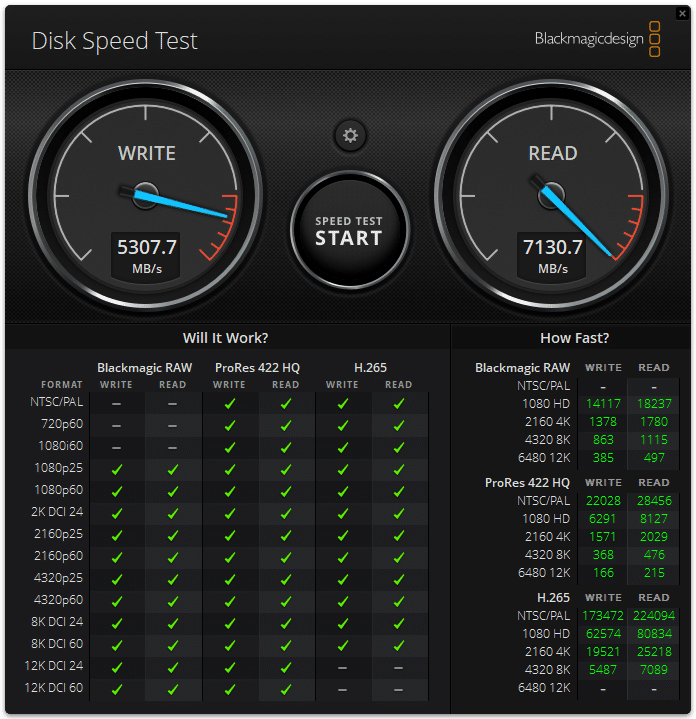
UL Procyon AI Inference
UL’s Procyon estimates a workstation’s performance for professional apps. On each system, we ran the test once on the CPU and once on the GPU. The Precision 5860’s Xeon chip is far stronger, but on the GPU side, the Precision 5680’s laptop GPU was competitive. Granted, it only has 16GB of VRAM to draw off whereas the Precision 5860’s RTX A6000 has a whopping 48GB.
| UL Procyon Average Inference Times (Lower is better) | Dell Precision 5680 (Intel Core i9-13900H) | Dell Precision 5680 (RTX A5000 Ada) | Dell Precision 5860 (Intel Xeon w7-2495X) | Dell Precision 5860 (NVIDIA RTX A6000) |
| MobileNet V3 | 1.69 ms | 0.62 ms | 1.84 ms | 0.60 ms |
| ResNet 50 | 15.23 ms | 1.69 ms | 6.73 ms | 1.50 ms |
| Inception V4 | 46.06 ms | 5.20 ms | 18.58 ms | 4.62 ms |
| DeepLab V3 | 51.84 ms | 4.84 ms | 24.63 ms | 3.94 ms |
| YOLO V3 | 107.40 ms | 5.20 ms | 30.53 ms | 4.49 ms |
| Real-ESRGAN | 4,825.08 ms | 145.23 ms | 1,570.19 ms | 127.51 ms |
Conclusion
The Dell Precision 5680 really impressed us in overall performance, especially on the GPU side. Its NVIDIA RTX A5000 Ada Generation even kept up with a desktop RTX A6000 card in some of our tests, which is quite the achievement for a laptop that’s about half an inch thin and weighs 4.5 pounds.
We also enjoyed the Precision 5680’s strong metal design and gorgeous OLED touchscreen. On the downside, we’d like to see a more well though-out keyboard and at least one USB-A port, both of which would make this laptop more practical.
Overall though, the 5680 is a powerful PC and a sensible choice for road warriors that want something comparable to desktop workstation performance without the heft.




 Amazon
Amazon